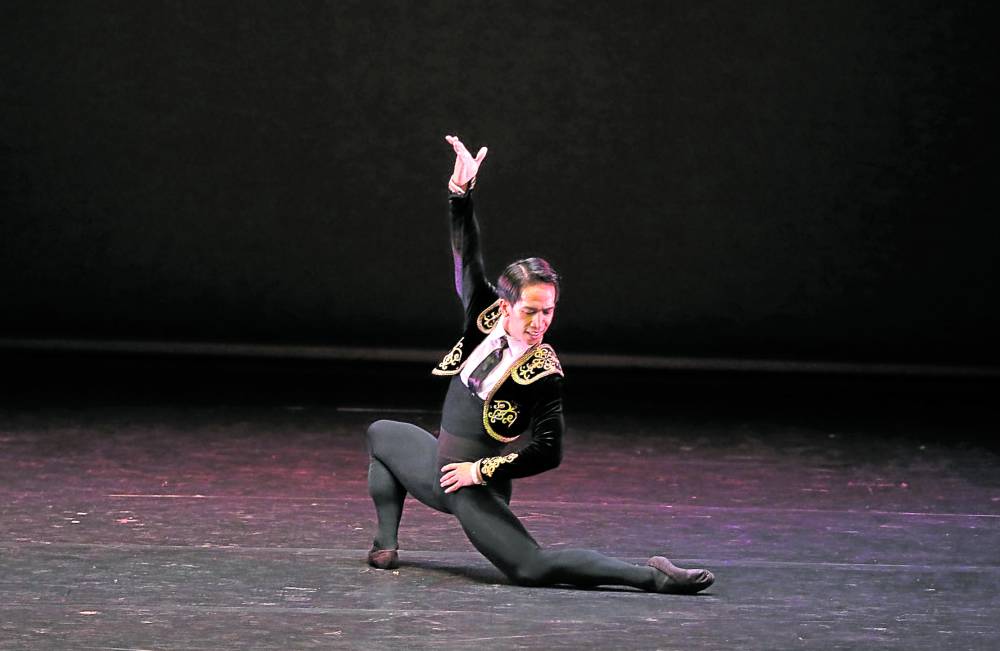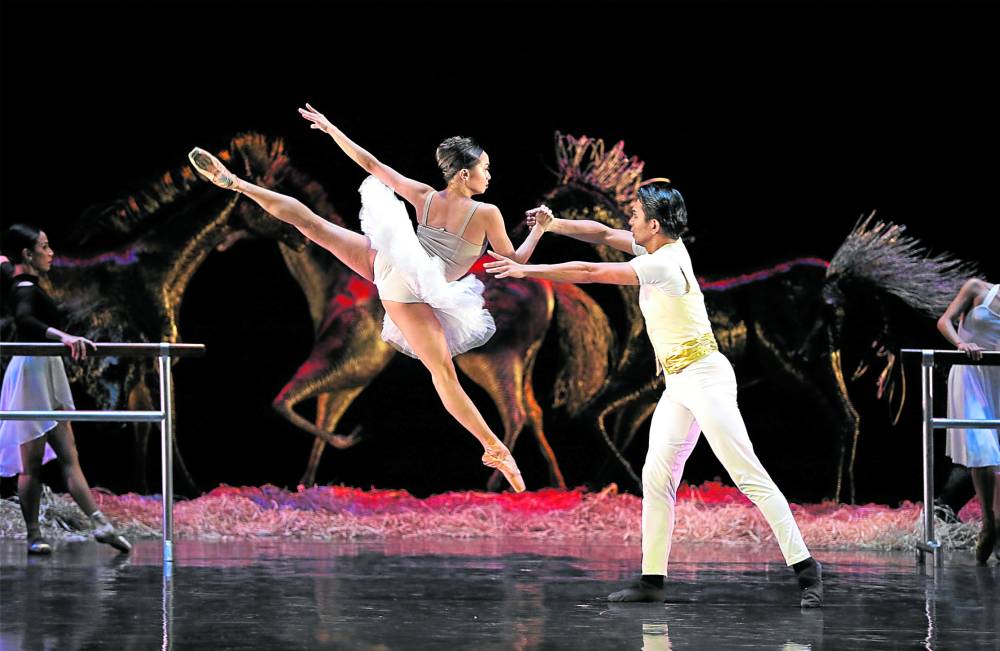Three companies rebooted their seasons in live theater, eager to show something familiar and something new. Ballet Philippines (BP) was “bolder” and “stronger” with the addition of guest dancers who were the cream of their respective companies. Though BP’s gala at the Cultural Center of the Philippines (CCP) presented the underwhelming works of BP’s first foreign artistic director, Mikhail Martynyuk wisely highlighted the dancers’ mettle in classical ballet.
Then there’s a streamlined Ballet Manila’s (BM) grand restaging of “La Traviata” at the refurbished Aliw Theater.
The newbie Alice Reyes Dance Philippines (ARDP), not a resident company of CCP, created its niche with its contemporary and heritage repertoire. Ballet Philippines

Under BP’s Guest Artists Program, select dancers from pandemic-impacted companies such as BM and Philippine Ballet Theater have been financially sustained and performing with BP. Martynyuk’s version of classical dances showed off their individual strengths. Guest artists from BM—Brian Sevilla, Elpidio Magat, Rudolph Capongcol and Joan Sia—performed with ease and brilliance. Yet, BP’s gains in having a powerful company were marred by Martynyuk’s sluggish and bland choreography.
“Dance Through Time” was an illogical juxtaposition of hackneyed Philippine historical and cultural images, on the pretense of celebrating our heritage put at the service of Martynyuk’s ballet. The most glaring: a painting of Lapu-Lapu slaying Magellan in the Battle Mactan, superimposed with the words “ … the world marveled at Filipino hospitality and culture.”
More jarring was the disconnect between Philippine culture and the ballets. Images of the country’s colonial churches segued to the ballroom scene of “Romeo and Juliet,” set against a photo of an Italian palazzo. Archeological diggings from our national museums preceded an Arabian “Scheherezade.”
Jose Rizal’s final days, martyred priests Fathers Mariano Gomes, Jose Burgos and Jacinto Zamora, Filipino revolutionary soldiers and an explanatory text on the fight for freedom from colonization moved on to a pas de deux, “Filibuster.” Dancing the title role, Sevilla, though erroneously dressed in a military-inspired top, showed his natural gifts in all facets of dance. If the choreography was making a reference to Rizal’s “El Filbusterismo,” why make a sappy and happy pas de deux when all the main male characters in that novel had doomed romances?
Photos of “Pandango sa Ilaw,” the gong dance of the Igorots and the Maranao singkil, were put together with dancers in 18th-century European costumes in “Figaro.” The dance’s only saving grace was the flamboyance of Peter San Juan. Likewise, the unrelated images of ancient Tagalog script and the arrival of the Spaniards followed by “Tarantela,” a fast dance of Italian origin, was unsettling. Still, “Tarantela” showed the company’s tidy technique even after lockdowns.

Much of Martynyuk’s choreography fell on repetitive passages just to fill up the music. The pas de deux lacked interaction between the couples that the duets ended up as glorified classroom exercises. These became obvious in a sluggish “Bolero.” Ravel’s music was wasted on redundant arm and shoulder movements and phony Spanish flair. We felt sorry for the lead, Jemima Reyes, who looked like an exhausted gym instructor by the end of this “dance by numbers.”
Contrary to perception, Martynyuk’s version of “Equus” was not a reference to Peter Shaffer’s psychosexual play about a psychiatrist, a boy’s clinical obsession with horses and his lover. While “equus,” referred to a group of hoofed mammals, the term was used an imagery for industrious dancers as workhorses. Ian Ocampo was the taskmaster overtaxing the dancers who mimicked horse movements. In an irony, Ocampo’s character became exhausted like an animal for labor. Jemima Reyes gave him a pail to drink like a horse.
The choreographer’s experiments with contemporary dance faltered due to, yet again, insufficient movement motivation and dramatic tension. Some dancers delivered spoken text, but they didn’t have proper vocal warm-up to project their lines.
Alice Reyes Dance Philippines
ARDP’s back-to-back tribute to the two National Artists for Dance, Reyes and Agnes Locsin, was met with mixed reviews. Although the dancers poured their hearts out in the restaging of master works, they were compared with the original casts who had worked with Locsin’s Neo-Ethnic classics (modern interpretation of indigenous rituals).
“Igorot” and “Moriones” were, at best, a platform for ARDP’s photogenic body lines, big jumps and powerful strokes. The dancers lacked the depth of internalizing their roles and in understanding the choreographic intentions.
“Igorot” was a nonnarrative suite depicting vignettes of life in the Cordilleras—the priestess communing with the gods, the hunters retelling their hunt and a courtship. Set to ethnic music, the choreography was based on movements from different tribes. Launched in 1987, the dance was groundbreaking for using pointe work, not to defy gravity as in the classical tradition, but to ground the dancers to the earth. Locsin was ahead of her time in cross-dressing the female dancers with G-strings and turning them into androgynous Amazons.
The revival felt incomplete. We were told that the dances of the maidens were deleted, due to lack of synchronicity during rehearsals. This was an important element, because the unison in folk dances was one of the inspirations for this piece.
“Moriones,” an all-male dance, focused on the masked Roman soldiers search for Longines, the soldier who pierced Christ on the Cross. Using Philip Glass’ upbeat music, Locsin used stunts to form human pyramids, explosive ballistic movements and exaggerations of the upper body to highlight the mask. The dancers’ exuberance was infectious, but the boys needed to take more risks.
“Elias at Salome,” inspired by the fated lovers in “Noli Me Tangere,” came alive through the interpretations of Biag Gaongen and Janine Arisola. As the feverish prisoner awaiting his fate, Gaongen sensitively physicalized his performance, his flexibility and emotions suggested his pain yet passion for Salome. Arisola danced with rapturous abandon in releasing Salome’s suppressed feelings. The suppleness of her upper body and deep hip thrusts were full of fervor.
Alice Reyes’ “Carmina Burana” was based on medieval poems and songs about monks who let go of monastical disciplines and ruminated on the rise and fall of fortune. Many local reviews have often described her work as a spectacle, empowered by Carl Orf’s music, Monino Duque’s dramatic lighting and National Artist Salvador Bernal’s symbolic cauldron and costumes that helped the story. The audience loved the movements for their hypnotic quality. To me, the expression and dynamics of the dancers in some sections were not powerful enough to differentiate one song from the other.
The recent “Premiers and Encores” was expectedly a winner, since most of the pieces were set on the dancers with the exception of the pas de deux by French choreographer Rheda (who rarely uses his surname Benteifour). The combined forces of emerging choreographers with a master showed similarities in style.
It’s been 30 years since the New French Dance was introduced to the Philippines. Characterized by odd gestures, geometrical arrangements of dancers matched with sharp but elaborate movements, the genre has been visible in the works of contemporary Filipino choreographers.Originally choreographed for video for CCP’s 2021 virtual dance series, JM Cabling’s “I Wanna Say Something” looked into the typical Pinoy mentality of self-repression. Cabling wove irony by making the central character, Erl Sorilla, dance with a microphone. Sorilla’s frantic reaches out in space sent the message that he wanted to express himself but was held back by his psyche.
Performed by students from Guang Ming College Tagaytay, the ensemble symbolized social pressure. Sorilla’s sinewy and deliberate movements contrasted with the ensemble’s frenetic pacing and sharp angles of the arms and torso.
“Visayan Suite” was an engaging reading of folk songs about celebration, courtship, carousing, broken hearts, work and power play. All the featured choreographers respected the lyrics even if the audience didn’t understand the dialect. They saw the clarity in their objectives and were moved by the experience of each piece.
In Erl Sorilla’s “Ay Kalisud (Ah, Misery),” the delicate Monica Gana was a revelation as the overwrought, jilted virgin deteriorating from insanity to death. As a contrast, couples danced in the background and watched the slow demise in detachment. Another surprise, Renzen Arboleda delighted in his spirited performance in Al Abraham’s “Kada Palingkamut.”
Rheda used art to mirror the times. “L’Espoir des Lendemain (Hope for Tomorrow)” foretold of things worsening before they get better. Through the years, his works have kept the audience riveted with his signature moves—whipping hair, androgynous men in skirts, the contrast of slow, fluid movements with sudden outbursts, the unexpected drops, spoken words, women ricocheting to their partners’ arms, the use of the chair and bodies collapsing from jumps. In the end, a dancer’s desperate cry of hopelessness was neutralized by another signature, filling up the stage with confetti to signify hope.
Another strength of the piece was Rheda’s compositions onstage, inspired by Renaissance masters.
“Man Seated on an Armchair” reflected dysfunctional relationships of today wherein the woman consumes her feelings for her man while he forcibly gives back. Rheda used repetition of movement passages to emphasize despair. Macel Dofitas danced with heartbreaking vulnerability while she drew a passionate yet inconsolable response from Yadao. Using his theater training, Yadao commanded attention through the power and clarity of his voice. Their turbulent duet mesmerized the audience into their world, enabling us to feel with them.
Ballet Manila
“Rise” aptly described the emergence of newly renovated Aliw Theater with state-of-the-art lighting and sound system after it was burned down in 2019. The twin-bill program was a balance of high art and pop culture. BM’s “Ballet and Ballads” celebrated Original Pilipino Music performed by guest artist Bituin Escalante and dances by Gerardo Francisco, the late Tony Fabella, Lisa Macuja Elizalde and British guest choreographer Martin Lawrence. Elizalde treated the audience to a performance accompanied by a 60-piece orchestra conducted by Gerard Salonga and opera singing in “La Traviata,” topbilled by Jade Riccio and Ivan Nery. The orchestra and chorus sounded heavenly with the acoustics.
Fabella’s interpretation of National Artist for Music Ryan Cayabyab’s “Nais Ko” was an apt post-pandemic number. Known for his musicality and sensitivity to lyrics, he conveyed the desire for freedom of movement and the idea of flight. The showcased BM’s strength, the male ensemble who burned the stage with their suspended leaps and high-octane energy.
Elizalde’s “La Traviata” was based on the opera of the same title about a courtesan, Violetta, who falls in love with bourgeoisie, Alfredo Germont. When their relationship scandalizes his family, Alfredo’s father, Giorgio, asks her to break away from her son. The three-act opera was crammed into a short ballet, leaving out character development and the reasons behind the conflicts between characters. It failed to establish that Violetta was torn between love and wanting a better life, hence the affair with the Baron. Ravishing in looks, Abigail Oliveiro was subtly seductive as the courtesan but a little wobbly on gala night. Her portrayal lacked dramatic arc. Mark Sumaylo, as Alfredo, didn’t have much substantial dancing, and ended up being a handsome partner who emoted on cue.
Elizalde is still exploring her choreographic skills. Some parts had interesting movements while others tended to look academic and predictable. Given time and more opportunity

